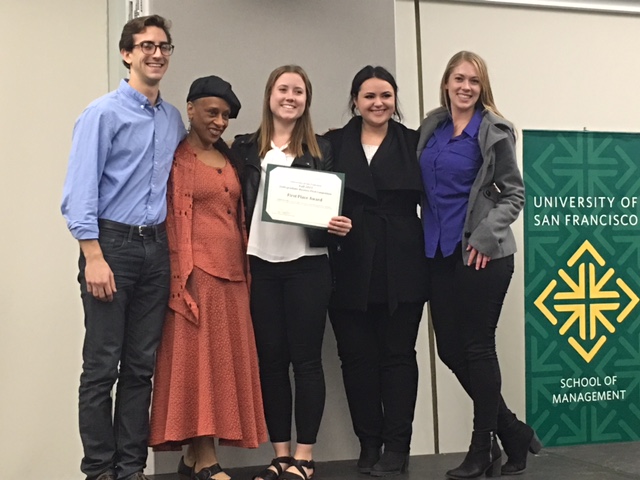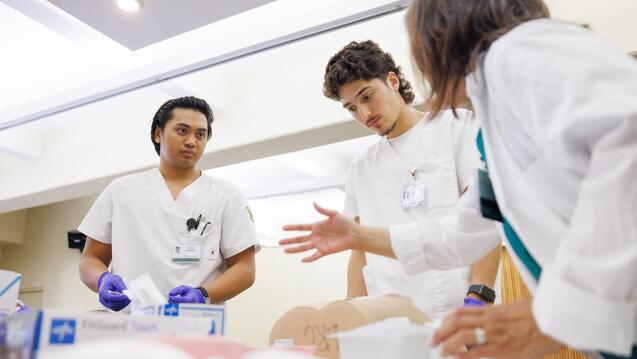
Creativity & Innovation | They’re alive and well and living at USF
Guest blogger Lary R Kirchenbauer develops workshop programs and teaches in the Gellert Family Business Resource Center, Executive Education Immersion Programs and Entrepreneurial Studies program at the USF School of Management and is the founder of Exkalibur.com.

Last [semester], as an Adjunct Professor at USF, I had the opportunity to once again participate as a judge for the Fall 2015 University of San Francisco Undergraduate Pitch Competition.
If you’re concerned about the ambitions and creativity of graduating students these days, don’t be. They’re on it.
The Entrepreneurial Studies Program is part of the School of Management at the University of San Francisco, which is ranked in the Top 20 of America’s Most Entrepreneurial Research Universities by Forbes (August 2015). An important part of this program is the Annual Pitch Competition which has been held in 31 consecutive semesters over a 16 year period. Dr. Mark Cannice is the Department Chair and Professor of Entrepreneurship and Innovation at USF. Dr. Monika Hudson is the principal organizer and presides over this challenging and entertaining event, attended by more than 200 students.
The Spirit of Creativity is Alive and Well and Kicking
The Undergraduate Pitch Competition highlights the spirit of innovation and creativity among graduating seniors seeking a business degree.
In short, the students are graded in these categories:
Delivery:
- Eye contact (looked at/connected with audience),
- Movement (expressive, comfortable),
- Voice (rate, pitch, is the volume natural?),
- Fluency (articulation is clear and smooth).
Content:
- Introduction – does it gain our attention?
- Is the customer pain defined?
- What market research/validators can be identified?
- What’s the marketing strategy and value proposition?
Viability:
- Would you willingly put $100,000 of your money into the concept as presented?
Effectiveness:
- A clear “ask” for a specific investment amount.
- A specific plan of how the proceeds will be used.
Each team had 90 seconds without visual aids to make its pitch. The panel of judges had two minutes for questions, comments and suggestions.
Ingenuity and Service are Prevalent
One of the most striking observations is the genuine interest that so many teams take in meeting the needs of underserved populations. Their interests cover a wide range, from senior citizens to neighborhoods without fresh produce, to underdeveloped countries, sports injuries and alcohol rehabilitation.
These students are interested in serving customers across a vast array of interests:
- inadequate healthcare records,
- poor eating habits,
- addiction challenges,
- services required in areas lacking electricity and water,
- access to medical services,
- pollution and air purification,
- physical disabilities …
… and a myriad of other worthy areas of interest.
Here are some of this year’s ideas
While this short list doesn’t do justice to the more than 32 teams who participated, I want to share a few of the creative and innovative business ideas that were “pitched” during the 90 seconds each team was given:
- An air purification mask using special technology that purifies the air around you, focused initially on children with asthma.
- A wearable device that helps the visually impaired navigate around obstacles in their environment.
- Hand-woven purses and bags made from defective foil wrap provided by potato chip manufacturers, intended to provide jobs in undeveloped economies.
- An advanced sports mouth guard that contains an electronic chip to measure impact that can immediately alert sideline observers about potential concussions.
And the Winners Are?
There is a 1st, 2nd and 3rd place award along with two special awards for sustainability and innovation:
- Social Seniors – a plan to keep seniors connected to their community and to each other.
- WIQ – a self-serve cleaning technology (seemingly similar to dry-cleaning) that can be deployed without electricity and water and allows for garment cleaning within 10 minutes.
- Care Card – medical information on an electronic card for less developed countries.
The Innovation Award was for a condom that overcomes the claimed 18% deficiency in pregnancy prevention using existing products. As in the grocery business where the packaging changes color when the food inside is exposed to oxygen (signifying that the packaging seal has been broken), it uses a technology that changes the color of the condom when it has been torn or punctured.
The Sustainability Award was for a mobile grocery store that offers fresh produce to underserved areas where it is unavailable.
There’s so much more
This year, there were many powerful and compelling personal stories shared during the competition. One student announced he was an alcoholic, had been in jail and in and out of rehab and wanted to connect students “who are like I used to be” with students “like I am today” … sober for over 2 years.
Another student, spearheading the Sustainability Award winner, shared his story. He unexpectedly became a father at 16, and is determined to overcome the reported 18% failure rate of existing condoms.
It was a pleasure to serve again as a judge at this event, and to be a witness to the talent, creativity and ingenuity of these business students.
This article was originally published on the Sword Tips blog at Exkalibur.com.


